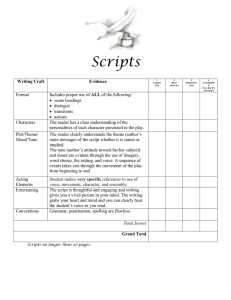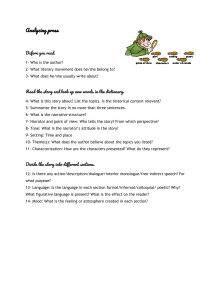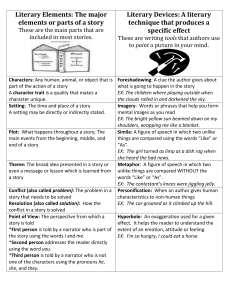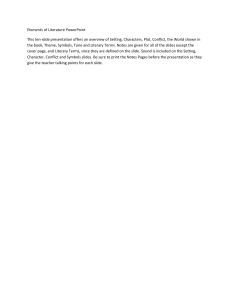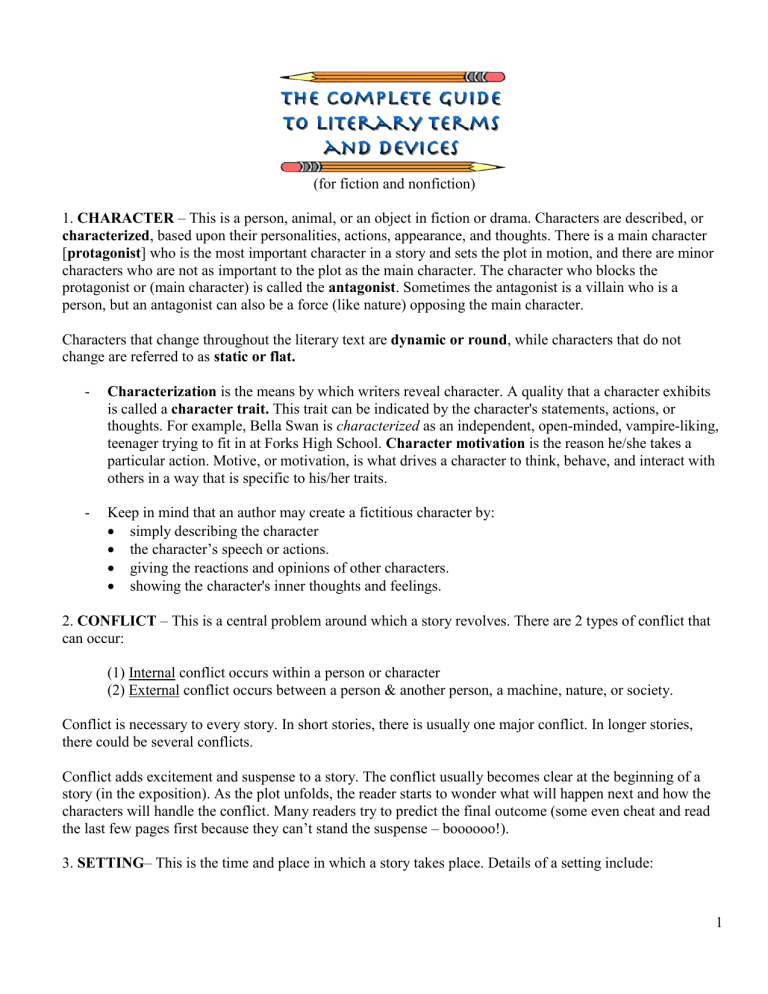
(for fiction and nonfiction) 1. CHARACTER – This is a person, animal, or an object in fiction or drama. Characters are described, or characterized, based upon their personalities, actions, appearance, and thoughts. There is a main character [protagonist] who is the most important character in a story and sets the plot in motion, and there are minor characters who are not as important to the plot as the main character. The character who blocks the protagonist or (main character) is called the antagonist. Sometimes the antagonist is a villain who is a person, but an antagonist can also be a force (like nature) opposing the main character. Characters that change throughout the literary text are dynamic or round, while characters that do not change are referred to as static or flat. - Characterization is the means by which writers reveal character. A quality that a character exhibits is called a character trait. This trait can be indicated by the character's statements, actions, or thoughts. For example, Bella Swan is characterized as an independent, open-minded, vampire-liking, teenager trying to fit in at Forks High School. Character motivation is the reason he/she takes a particular action. Motive, or motivation, is what drives a character to think, behave, and interact with others in a way that is specific to his/her traits. - Keep in mind that an author may create a fictitious character by: simply describing the character the character’s speech or actions. giving the reactions and opinions of other characters. showing the character's inner thoughts and feelings. 2. CONFLICT – This is a central problem around which a story revolves. There are 2 types of conflict that can occur: (1) Internal conflict occurs within a person or character (2) External conflict occurs between a person & another person, a machine, nature, or society. Conflict is necessary to every story. In short stories, there is usually one major conflict. In longer stories, there could be several conflicts. Conflict adds excitement and suspense to a story. The conflict usually becomes clear at the beginning of a story (in the exposition). As the plot unfolds, the reader starts to wonder what will happen next and how the characters will handle the conflict. Many readers try to predict the final outcome (some even cheat and read the last few pages first because they can’t stand the suspense – boooooo!). 3. SETTING– This is the time and place in which a story takes place. Details of a setting include: 1 - Time/Historical Period – the general period of the plot and the main location of the story (ex – the story took place during the 1960's at Woodstock) - Physical Features – what the place/location of the setting looks like physically (ex – mountains, streams and fields of grass) - Geographic Location – the actual location of the place (ex – the story took place in China Town of NYC) 4. PLOT (or Narrative Arc) – This is the series of events that make up the story or drama/play. The parts of plot are: Exposition, Rising Action, Climax, Falling Action and Resolution/Denouement. - Exposition – Here readers are exposed to information that will later be necessary for them to have if they are to understand the unfolding story. It is the part of a work of fiction where readers learn about the characters and the conflicts they will experience. It is sometimes referred to as the basic situation; it provides needed background information. - Rising Action - Usually, there is no clear boundary between exposition and rising action; rather, there is a gradual merging of the two. In this section of the story, complications emerge and eventually a dominant conflict becomes clear. The range of conflicts looks like this: 1. In early literature, the conflicts were Man vs. Man, Man vs. Nature, and Man vs. Self. 2. As fiction evolved and psychological theories, technological advances, and urbanization occurred, the list expanded to include Man vs. Society, Man vs. Technology, and Man vs. Alter Ego. 3. In the age of film, these others exist, but as the 20th century unfolded, the list expanded yet again. Today, we add Man vs. Alien Society, Man vs. Biotechnology, and Man vs. Cloned Self to the ever-growing list - Climax – or the turning point of the action; this is usually where the main character makes the single big decision that defines the outcome of their story and who they are as a person. The climax often contains much of the action in a story, for example, a defining battle. - Falling Action - This is the part of the plot that occurs after the climax has been reached; it is the part where loose ends are tied up and leads to the resolution of the conflict. 2 - Resolution – This is the solution to the conflict. It is often called the denouement – or how the story ends. 5. FORESHADOWING – This is clues in the text that hint as to things that will happen later in the plot. Foreshadowing is usually more subtle and works on the symbolic level. For example, if a character must break up a schoolyard fight among some boys, it might symbolically foreshadow the family squabbles that will become the central conflict of the story. You usually can find foreshadowing anywhere from the exposition to the falling action 6. FLASHBACK - are interruptions that writers do to insert past events in order to provide background or context to the current events of a narrative. 7. POINT OF VIEW (POV) – The voice telling the story is the narrator. Point of view refers to the voice in which the story is told. It is the set of eyes the author uses to let the reader see the action unfold. Of the three, first and third persons are the most commonly used in writing stories: - First-Person – One can spot first person point of view by the pronouns “I, we,” & “us”. With the use of first person, the narrator is an actual character in the story. His or her knowledge is, therefore, limited to that one person’s perspective. - Third-Person – When writing in third person, the narrator uses names of characters & pronouns like “he, him, she, her, they,” & “them.” If the narrator relates thoughts of only one character in the story, it is third person limited, as in limited to the knowledge of the thought process for that one character. In third person omniscient point of view, the narrator knows and relates not only the action of all characters in the story, but of each character’s thoughts as well, thus the term omniscient or all-knowing. - Second-Person – A narrator using second person is rather rare. The pronoun “you” is used in this type of writing. An example follows: “You feel the salt air on your skin. You feel alone and isolated on the beach; yet, you feel deep inside of yourself that you are not alone.” This POV is typically used in self-help books or advice columns. 8. SPEAKER – This is the person delivering the story. Remember, the speaker and the author are not necessarily one in the same. For example, in Langston Hughes (male) poem “Mother to Son,” the speaker is actually his mother, not him. 9. NARRATOR – This is a person who recounts the events of a novel or narrative poem., especially a character 10. EDITORIAL - a newspaper article written by or on behalf of an editor that gives an opinion on a topical issue. 11. FACT - states something that: Happens. (ex., “A lunar eclipse happens when the moon aligns exactly with the earth and sun.”) Has happened or is certain to be true. (ex., “Thomas Jefferson wrote the Declaration of Independence.”) Is real or exists. (ex., “The sun is a star.”) 3 12. OPINION - An opinion states something: Believed to have occurred. (ex., “The teacher gave us a pop quiz because she got mad at the class.”) Believed to exist. (ex., “The bus stop close to my house was built so I wouldn’t miss the bus again.”) Believed to be true. (ex., “Grandma and Grandpa love me the most.”) 13. BIAS - prejudice in favor of or against one thing, person, or group compared with another. For example, "readers said the paper was biased toward the conservatives" 14. IMAGERY – This is a set of mental pictures or images. It is the use of vivid or figurative language to represent objects, actions, or ideas. To make an imaginary world seem real, an author often makes use of words and phrases that appeal to the senses. These words and phrases, called images, help a reader mentally experience what the characters in the literary selection are actually experiencing. A well-written description should arouse a particular response or emotion in the reader's imagination. Sensory imagery is developed using the five senses: sight, sounds, taste, touch and smell. For example: The hot July sun beat relentlessly down, casting an orange glare over the farm buildings, the fields, the pond. Even the usually cool green willows bordering the pond hung wilted and dry. Our sun-baked backs ached for relief. We quickly pulled off our sweaty clothes and plunged into the pond, but the tepid water only stifled us and we soon climbed onto the brown, dusty bank. Our parched throats longed for something cool--a strawberry ice, a tall frosted glass of lemonade. 15. MOOD – Mood happens when authors use descriptive words/adjectives to create a certain feeling or mood in the reader of the story; it’s what the reader feels towards the subject of a story. Examples of mood might be: ominous, happy, depressing, exciting, and jubilant among many more. Mood is the general feeling or atmosphere that a piece of writing creates within the reader. Mood is produced most effectively through the use of setting, theme, voice and tone. - Setting often helps create mood in the reader. Often, the descriptive elements that surface early in a story establish a mood that can foreshadow the events of the story. Thus, a reader might leave the opening passages — the exposition phase of the tale — expecting suspense or lightheartedness or dire peril. 16. TONE – Tone encompasses the attitudes toward the subject and toward the audience implied in a literary work. Tone may be formal, informal, intimate, solemn, somber, playful, serious, ironic, guilty, condescending, or many other possible attitudes. Each piece of literature has at least one theme, or central question about a topic, and how the theme is approached within the work is known as the tone. - While now used to discuss literature, the term tone was originally applied solely to music. This appropriated word has come to represent the attitudes and feelings that a speaker (in poetry), a narrator (in fiction), or an author (in non-literary prose) has towards the subject, situation, and/or the intended audience. - It is important to recognize that the speaker, or narrator, of a piece of literature is not to be confused with the author. Likewise, the attitudes and feelings of the speaker, or narrator, should not be confused with those of the author. In general, the tone of a piece only refers to the attitude of the author if the writing is non-literary in nature. 4 - Tone and mood are not the same, although variations of the two words may on occasions be interchangeable terms. The tone of a piece of literature is what the speaker or narrator feels towards the subject, rather than what the reader feels. - All pieces of literature, even official documents, have some sort of tone. Authors create the tone of their piece of writing through the use of various other literary elements, such as diction, (or word choice); syntax, (the grammatical arrangement of words in a text for effect); imagery, (or vivid appeals to the senses); details, (facts that are included or omitted); and/or extended metaphor, (language that compares seemingly unrelated things throughout the composition). In many cases, the tone of a piece of work may change and shift as the speaker or narrator’s perspective on a particular subject alters throughout the piece. 17. SARCASM - Generally, the literal meaning is different than what the speaker intends to say through sarcasm. Sarcasm is a literary and rhetorical device that is meant to mock with often satirical or ironic remarks with a purpose to amuse and hurt someone or some section of society simultaneously. For instance: “I didn’t attend the funeral, but I sent a nice letter saying I approved of it.” (Mark Twain) 18. CONNOTATION - refers to a meaning that is implied by a word apart from the thing which it describes explicitly. Words carry cultural and emotional associations or meanings in addition to their literal meanings or denotations. For example, the word home, may have a positive connotation for some people, but it may have a negative one for those who have experienced trauma and/or abuse 19. DENOTATION - is generally defined as literal or dictionary meanings of a word 20. WORDS IN CONTEXT - Context clues are hints in a sentence or passage that can help you define a word you don't know. The clue may appear in the same sentence as the word you don't know or in a nearby sentence. 21. ALLUSION - is a brief and indirect reference to a person, place, thing or idea of historical, cultural, literary or political significance. It does not describe in detail the person or thing to which it refers. It is just a passing comment and the writer expects the reader to possess enough knowledge to spot the allusion and grasp its importance in a text. Examples include: “Don’t act like a Romeo in front of her.”– “Romeo” is a reference to Shakespeare’s Romeo, a passionate lover of Juliet, in Romeo and Juliet. OR, “The rise in poverty will unlock the Pandora’s box of crimes.”– This is an allusion to one of Greek Mythology’s origin myth, “Pandora’s box”. 22. IRONY – This is the difference or gap between what is said and what is actually meant in a text. The three forms of irony are: - Verbal irony – This is when a character or narrator says something but means exactly the opposite. An example might be, "Boy, she is really pretty" said about a muddy dog with burs in her fur. - Situational irony – This is the difference between what appears to be and what actually is true. It is often demonstrated by an actual result being different than what is expected. For example, a story's main character could find the bad guy & bring him to justice, but walk out of the police station and be killed by a train. It is kind of like a surprise ending. 5 Dramatic irony – This occurs when the reader/observer knows something that the character in a written text does not know. For instance, a woman might think that her husband has forgotten her birthday, but the reader/audience knows that he has really bought her a diamond ring that is hidden in her dessert at dinner. - 23. SYMBOL - This occurs when something specific is used to represent something abstract. It is when an object is meant to be representative of something or an idea greater than the object itself. Cross - representative of Christ or Christianity Bald Eagle - America or patriotism Owl - wisdom or knowledge Yellow - implies cowardice 24. THEME – This is the underlying focus of a story. Subjects or main ideas of works can often be expressed in one word, ex., love. But, a theme is underlying; a theme is something the writer wants the reader discover. Some universal literary themes are: - Love will endure and triumph over evil. Heroes must undergo trials and endure losses before they can claim their rightful kingdom. Arrogance and pride can bring destruction When the rule of law is broken, chaos and anarchy will result. * Note - There may be more than one theme in a literary work. 25. STANZA - refers to a smaller unit within a poem or a verse within a song, stanzas are available in even the first section of the poem. They are usually grouped together by the rhyme pattern and/or number of lines that they have. 26. RHYME - identity in sound of some part, especially the end, of words or lines of verse. a word agreeing with another in terminal sound 27. METER - is the rhythm established by a poem, and it is usually dependent not only on the number of syllables in a line but also on the way those syllables are accented. This rhythm is often described as a pattern of stressed and unstressed syllables. 28. LITERAL LANGUAGE - refers to words that do not deviate from their defined meaning. Nonliteral or figurative language refers to words, and groups of words, that exaggerate or alter the usual meanings of the component words. 29. FIGURATIVE LANGUAGE – This is the use of words to express meaning beyond the literal meaning of the words themselves: Metaphor - contrasting to seemingly different things to enhance the meaning of a situation or theme without using like or as o You are the sunshine of my life. 6 Extended Metaphor - refers to a comparison between two unlike things that continues throughout a series of sentences in a paragraph or lines in a poem. Simile - contrasting to seemingly different things to enhance the meaning of a situation or theme using like or as o What happens to a dream deferred, does it dry up like a raisin in the sun? Onomatopeia - the formation of a word from a sound associated with what is named (ex: cuckoo, sizzle ). Hyperbole – an exaggeration o I have a million things to do today. Alliteration - the occurrence of the same letter or sound at the beginning of adjacent or closely connected words. Example – She sells seashells by the seashore. The alliteration her is the “SH” sound. Personification - giving non-human objects human characteristics o America has thrown her hat into the ring, and will be joining forces with the British. 30. PARAPHRASE - is a restatement of the meaning of a text or passage using other words. 31. AUTHOR’S PURPOSE - is the reason an author decides to write about a specific topic. Then, once a topic is selected, the author must decide whether his purpose for writing is to inform, persuade, entertain, or explain his ideas to the reader 32. AUTHOR’S STYLE - is the literary element that describes the ways that the author uses words — the author's word choice, sentence structure, figurative language, and sentence arrangement all work together to establish mood, images, and meaning in the text. Style describes how the author describes events, objects, and ideas. 33. SEQUENCE – every story is made up of a sequence or an order of events 7
